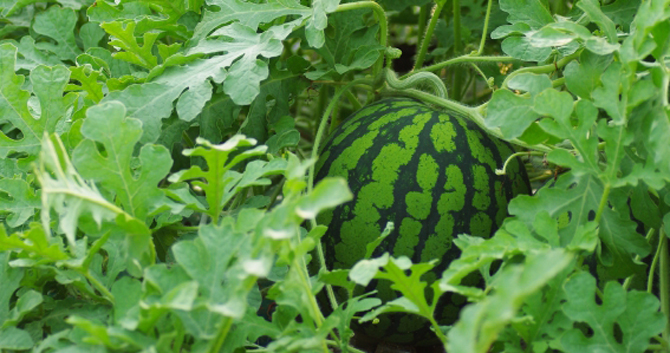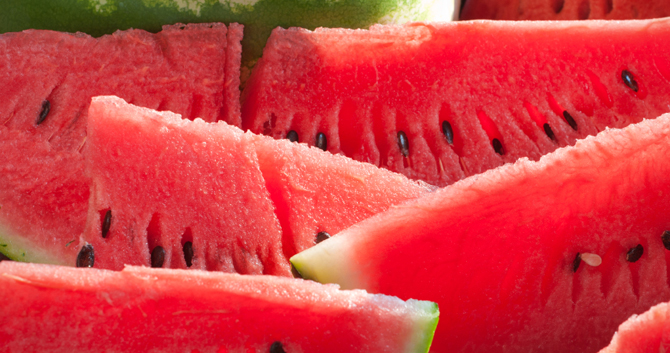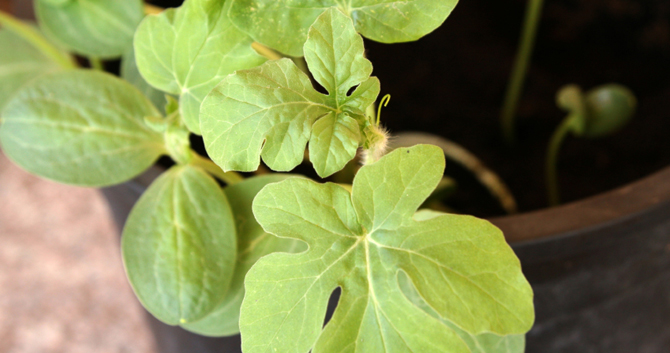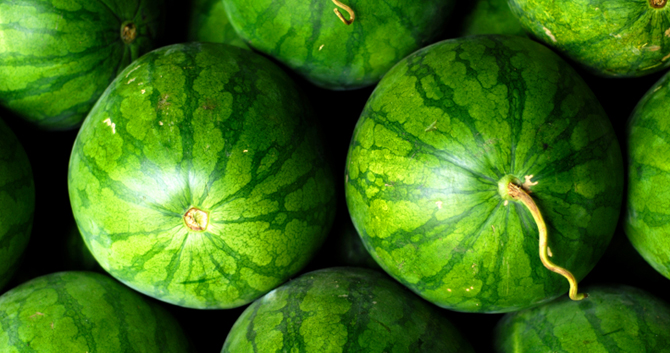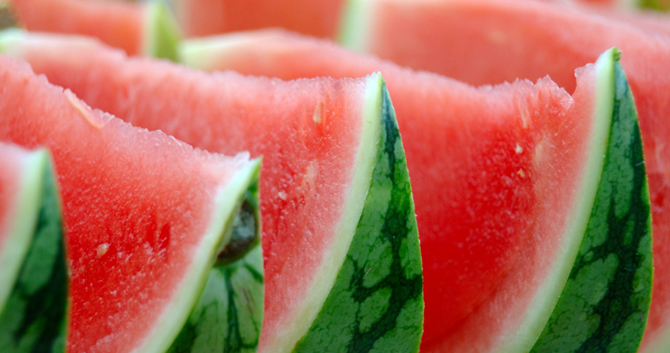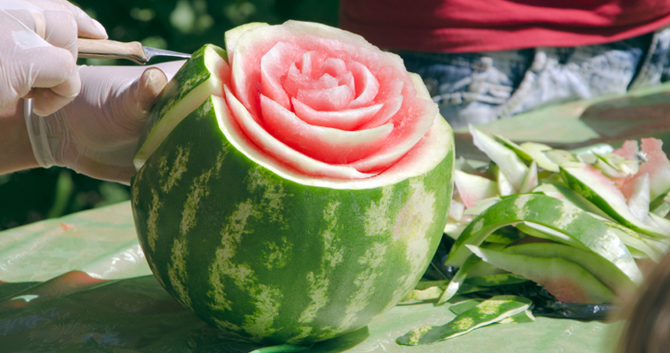Summertime and watermelon go hand in hand – officially one of the most popular summer fruits, no picnic, barbeque, beach outing, or backyard party is complete without one!
The sweet, juicy, delicious fruit is rich in antioxidants and a great way to cool down on a hot day. Surprisingly, every part of the watermelon is edible. The rind is more than just a handle to hold the dripping fruit or a container that’s carved into baskets and bowls - it’s also pickled and used in relishes, salsas, preserves and chutneys. Even the seeds are edible!
Watermelon originated in the deserts of Southern Africa, where it still grows wild today. Known as the Tsamma melon, this ancestor of today’s watermelons is a tough, drought tolerant plant prized in the Kalahari for its ability to store water as a help for tribes crossing the desert. It’s smaller than most modern varieties with a whitish fruit and strong flavor similar to the taste of the rind.
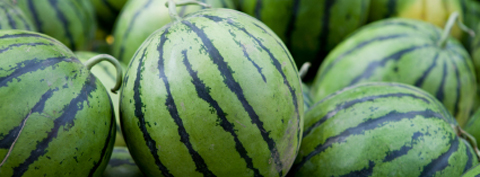 Watermelons are grouped into mini, icebox, picnic, seedless, and yellow/orange varieties
Watermelons are grouped into mini, icebox, picnic, seedless, and yellow/orange varieties
Under cultivation for millennia, watermelon seeds were found in King Tut’s tomb, dating back more than 5,000 years. Around the 10th century the watermelon found its way to China, currently the world’s number one producer of the fruit.
Watermelons are part of the Cucurbitaceae family and are closely related to squash, pumpkins, and cucumbers. But did you know that the watermelon is classified by botanists as a berry? They are classed as pepos, meaning berries with thick hard rinds and fleshy interiors.
Types of Watermelons
There are over 1,200 varieties of watermelons worldwide in all sizes, shapes, and colors. The outer rind can be solid, striped or speckled in shades of green, yellow and white. While most are red inside, there are also orange, yellow, and even white varieties to choose from.
Generally, watermelons are grouped into five main types – mini, icebox, picnic, seedless, and yellow/orange fruit.
Mini watermelons are petite varieties that can weigh as little as four pounds. Small and relatively compact, they can be grown in containers and supported on trellises. These little cuties are also referred to as personal size. What will they think of next? The only way to describe them is red, crisp and juicy - not to mention delicious!
Icebox watermelon varieties were first introduced over 50 years ago to fit in home refrigerators. Ideal for smaller families, these varieties weigh in at around 5 to 15 pounds. Sweet and refreshing, they’ll disappear quickly after harvest! Look for varieties like Sugar Baby and Tiger Baby.
Picnic watermelons are the classic large varieties that feed a crowd, weighing between 15 and 45 pounds. Picnic watermelons supply all you can eat and still have enough for a watermelon eating contest. Look for varieties like Crimson Sweet, a large round watermelon with a honeyed taste that grows to 16 to 35 pounds; Jubilee, a giant among watermelons weighing between 20 and 45 pounds; and oblong "All Sweet" types that are high in sugar - weighing 18 to 30 pounds, there'll be plenty to go around.
 Watermelons need lots of sun and lots of space
Watermelons need lots of sun and lots of space
Seedless watermelons come in red, orange, and yellow varieties - although they have none of the mature black seeds, they all have small white immature seed coats, which are perfectly safe to swallow. Seedless varieties are medium-sized, ranging from 10 to 20 pounds.
Yellow/Orange Flesh watermelons are a departure from the classic red fruit. These round varieties, which range in size from 10 to 30 pounds, will definitely get your picnic guests’ attention. From the outside, they’re indistinguishable from the red ones, but cutting into them is a delightful surprise. The yellow to orange flesh is the first clue that this is not your grandmother’s watermelon, and the taste confirms it – these are generally sweeter than their red cousins. Yellow Crimson, Yellow Baby, or Yellow Doll are a worth trying.
Getting Started
Watermelons are easy to grow. These warm weather vines need at least eight hours of sun per day and 1 to 2 inches of water per week - so pick a sunny spot that you can reach with the hose. Plant early, but after danger of frost, to give them plenty of time to produce top quality fruit. Look for varieties that will have time to ripen in your climate, as they often require about three months of reliably hot weather.
Watermelons prefer a loose, sandy, well-fertilized soil. They do not like wet feet, so drainage is extremely important. They’ll do best in raised beds or planted in 12” mounds or ‘hills’ created with good soil and lots of compost.
Care Tips
Provided with a good location and some tender loving care, vines can spread 6 to 8 feet in a month! With some help from bees to pollinate the flowers, a single vine can produce two to six melons, depending on the variety - smaller varieties generally produce more fruit than larger varieties.
Planting
Watermelons are usually planted in hills of 2 plants, spaced 8 to 12 feet apart to give plants plenty of room to grow, good air circulation and space for pollinators to work.
Watering
Watermelon plants need consistent moisture. Water deeply as needed to keep soil moist, rather than apply frequent, shorter sprinklings. Once flowers emerge, water plants thoroughly every three days. The best time to water is mid-day, after the flowers and fruit have had time to set and the bees have visited. Prevent disease by watering at the base of the plants instead of using overhead sprinklers.
Adequate water is especially critical right after plants bloom and as they approach harvest. This will prevent misshapen fruit and reduced size at harvest.
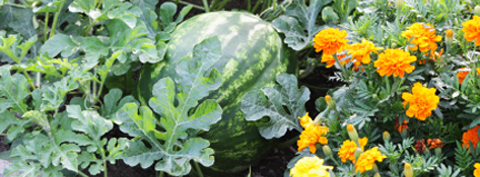 You'll know a watermelon is ripe when the tendrils turn brown
You'll know a watermelon is ripe when the tendrils turn brown
Mulching
To help ensure plants stay moist and well-fed, apply a 2 to 3 inch layer of composted mulch after planting. The mulch should be kept a few inches away from the seedling’s stems, and will provide a weed-free space for the vines to tumble across.
Fertilizing
Watermelons are heavy feeders, using the nutrients to grow large and strong. Use a high nitrogen fertilizer to get them off to a good start. Give them lots of potassium when they flower and start to grow fruit. Choose a product formulated for fruiting vegetables and follow package directions.
Pruning
When the vines have reached around twelve feet long, snip the end of the vine to encourage branching.
Harvesting
Watermelons will not ripen after picking, so it’s important to wait until they are fully mature. Look for these signs that your watermelons are ready for harvest:
- Vine tendrils to begin turning brown and dying off
- Thump the melon—you should hear a dull sound
- The soil side of a watermelon will turn from white to pale yellow
- Ripe melons will have a sweet aroma at the stem end
During the last week or so before harvest, after melons have reached a good size, reduce watering to concentrate sweetness.
Companion Plants
Take advantage of plants that grow well with watermelons to deter pests, enhance flavor, encourage growth, or improve health. The following plants are beneficial to watermelons:
Nasturtium and oregano help deter aphids.
Radishes ward off cucumber beetles, which may also munch on watermelons.
 Nasturtiums are a great companion for watermelons, keeping pests to a minimum
Nasturtiums are a great companion for watermelons, keeping pests to a minimum
Several edibles share space well with watermelons, using the garden plot to full advantage. Consider the following:
- Corn shields watermelon vines and fruit from the wind
- Sunflowers attract pollinators and also provide wind protection
- Pumpkin and squash require similar growing conditions
Troubleshooting
Watermelons are fairly problem free, but can struggle when Mother Nature does not cooperate or when growing conditions are less than ideal.
Plants that produce abundant foliage and few fruits are likely spaced too closely together and are not getting adequate pollination or air circulation.
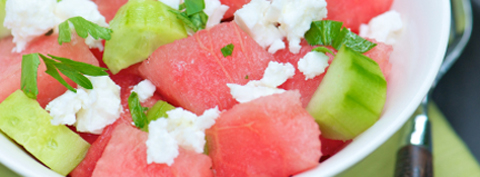 Watermelons make a refreshing summer salad when mixed with mint and feta cheese
Watermelons make a refreshing summer salad when mixed with mint and feta cheese
If flowers shrivel without turning into fruit, they lack pollination and your bees need a motivational talk. If that doesn’t work, you can hand pollinate by using a small brush to rub the pollen from the male flower onto the female. Look for a green bulge at the base of the flower—these are the female blooms.
Mildewed leaves can be a problem, especially in humid weather. Wet leaves can promote growth of fungus disease that coats the surface with dull white. Help prevent this condition by applying water directly to the base of the plant, or using soaker hoses instead of overhead sprinklers.
Misshapen or bitter fruit is likely caused by dry soil, high temperatures, or inadequate nutrients. Keep plant mulched, well watered, and fertilized to avoid this disappointment.

